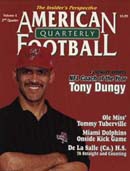AMERICAN FOOTBALL MONTHLY THE #1 RESOURCE FOR FOOTBALL COACHES
Article CategoriesAFM Magazine
|
The Cowboy WayWyoming's 4-3/3-4 Combo Schemeby: Vic Koenning Defensive Coordinator, University of Wyoming © More from this issue At the University of Wyoming great offenses have been the norm. The Cowboy defense has taken a "bend but don't break" mentality. That scheme and mentality gave up a lot of yards and points in 1996, but the Cowboys were strong enough offensively to earn a 10-2 record and a Pacific Division Championship. With the arrival of Coach Dana Dimel as the Cowboys' new head coach, the philosophy and focus went towards establishing the Wyoming defense as an "attack" style defense. As defensive coordinator for the Cowboys' new scheme, I was entrusted to establish our defense as one to be respected, in a conference known for offensive fire power. As our defensive staff began to develop our package, we first evaluated our players and their abilities. We had two returning defensive ends from 1996's 4-3 scheme and several really youn....The full article can only be seen by subscribers.
|
|
|||||||
| HOME |
MAGAZINE |
SUBSCRIBE | ONLINE COLUMNISTS | COACHING VIDEOS |
Copyright 2025, AmericanFootballMonthly.com
All Rights Reserved





